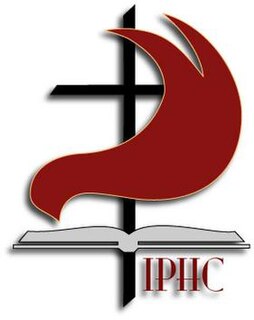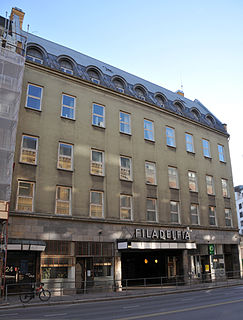Related Research Articles

Pentecostalism or classical Pentecostalism is a Protestant Charismatic Christian movement that emphasizes direct personal experience of God through baptism with the Holy Spirit. The term Pentecostal is derived from Pentecost, an event that commemorates the descent of the Holy Spirit upon the Apostles and other followers of Jesus Christ while they were in Jerusalem celebrating the Feast of Weeks, as described in the Acts of the Apostles.
The Azusa Street Revival was a historic series of revival meetings that took place in Los Angeles, California. It was led by William J. Seymour, an African-American preacher. The revival began on April 9, 1906, and continued until roughly 1915. On the night of April 9, 1906, Seymour and seven men were waiting on God on Bonnie Brae Street, "when suddenly, as though hit by a bolt of lightning, they were knocked from their chairs to the floor," and the other seven men began to speak in tongues and shout out loud praising God. The news quickly spread; the city was stirred; crowds gathered; services were moved outside to accommodate the crowds who came from all around; people fell down as they approached, and attributed it to God; people were baptized in the Holy Spirit and the sick were said to be healed. The testimony of those who attended the Azusa Street Revival was "I am saved, sanctified, and filled with the Holy Ghost" in reference to the three works of grace of Holiness Pentecostals, the original branch of Pentecostalism. To further accommodate the crowds, an old dilapidated, two-story frame building at 312 Azusa Street in the industrial section of the city was secured. This building, originally built for an African Methodist Episcopal (AME) church, had more recently been used as a livery stable, storage building and tenement house. In this humble Azusa Street mission, a continuous three-year revival occurred and became known around the world. Stanley H. Frodsham, in his book, With Signs Following, quotes an eye-witness description of the scene: The revival was characterized by spiritual experiences accompanied with testimonies of physical healing miracles, worship services, and speaking in tongues. The participants were criticized by some secular media and Christian theologians for behaviors considered to be outrageous and unorthodox, especially at the time. Today, the revival is considered by historians to be the primary catalyst for the spread of Pentecostalism in the 20th century.

The Assemblies of God (AG), officially the World Assemblies of God Fellowship, is a group of over 144 autonomous self-governing national groupings of churches that together form the world's largest Pentecostal denomination.

The International Pentecostal Holiness Church (IPHC) or simply Pentecostal Holiness Church (PHC) is a Holiness-Pentecostal Christian denomination founded in 1911 with the merger of two older denominations. Historically centered in the Southeastern United States, particularly the Carolinas and Georgia, the Pentecostal Holiness Church now has an international presence. In 2000, the church reported a worldwide membership of over one million—over three million including affiliates.
The Latter Rain, also known as the New Order or the New Order of the Latter Rain, was a post–World War II movement within Pentecostal Christianity which remains controversial. The movement saw itself as a continuation of the restorationism of early pentecostalism. The movement began with major revivals between 1948 and 1952, and became established as a large semi-organized movement by 1952 and continued into the 1960s. The movement had a profound impact on subsequent movements as its participants dispersed throughout the broader charismatic and pentecostal movements beginning in the 1960s.

William Marrion Branham was an American Christian minister and faith healer who initiated the post–World War II healing revival, and claimed to be a prophet with the anointing of Elijah, who had come to prelude Christ's second coming; some of his followers have been labeled a "doomsday cult". He is credited as "a principal architect of restorationist thought" for charismatics by some Christian historians, and has been called the "leading individual in the Second Wave of Pentecostalism." He made a lasting influence on televangelism and the modern charismatic movement, and his "stage presence remains a legend unparalleled in the history of the Charismatic movement". At the time they were held, his inter-denominational meetings were the largest religious meetings ever held in some American cities. Branham was the first American deliverance minister to successfully campaign in Europe; his ministry reached global audiences with major campaigns held in North America, Europe, Africa, and India.

Charles F. Parham was an American preacher and evangelist. Together with William J. Seymour, Parham was one of the two central figures in the development and early spread of American Pentecostalism. It was Parham who associated glossolalia with the baptism in the Holy Spirit, a theological connection crucial to the emergence of Pentecostalism as a distinct movement. Parham was the first preacher to articulate Pentecostalism's distinctive doctrine of evidential tongues, and to expand the movement.
The Brownsville Revival was a widely reported Christian revival within the Pentecostal movement that began on Father's Day June 18, 1995, at Brownsville Assembly of God in Pensacola, Florida. Characteristics of the Brownsville Revival movement, as with other Christian religious revivals, included acts of repentance by parishioners and a call to holiness, inspired by the manifestation of the Holy Spirit. Some of the occurrences in this revival fit the description of moments of religious ecstasy. More than four million people are reported to have attended the revival meetings from its beginnings in 1995 to around 2000.

Rodney Morgan Howard-Browne is a South African-born American evangelist and conspiracy theorist. He has resided in Tampa, Florida, since the mid-1990s and is pastor of The River Church in Tampa Bay. The River is considered both Pentecostal and Charismatic with revival meetings, led by Howard-Browne, known for those in the audience breaking into "holy laughter" and experiencing other phenomena similar to the Great Awakenings and Azusa Street Revival. Howard-Browne is the head of Revival Ministries International, a ministry he and his wife founded in 1997.

The Apostolic Church is a Christian denomination and Pentecostal movement that emerged from the Welsh Revival of 1904–1905. Although the movement began in the United Kingdom, the largest national Apostolic Church is now the Apostolic Church Nigeria. The term "Apostolic" refers to the role of apostles in the denomination's church government, as well as a desire to emulate 1st century Christianity in its faith, practices, and government.

The Apostolic Faith Mission of South Africa (AFM) is a classical Pentecostal Christian denomination in South Africa. With 1.2 million adherents, it is South Africa's largest Pentecostal church and the fifth largest religious grouping in South Africa representing 7.6 percent of the population. Dr. Isak Burger has led the AFM as president since 1996 when the white and black branches of the church were united. It is a member of the Apostolic Faith Mission International, a fellowship of 23 AFM national churches. It is also a member of the South African Council of Churches.
The Australian Christian Churches (ACC), formerly Assemblies of God in Australia, is a network of Pentecostal churches in Australia affiliated with the World Assemblies of God Fellowship, which is the largest Pentecostal denomination in the world.
The Lakeland Revival, or Florida Healing Outpouring, was a Pentacostal revival which took place from April until October of 2008 in Lakeland, Florida, United States. The revival began on April 2, 2008, when evangelist Todd Bentley of Fresh Fire Ministries Canada was invited by Stephen Strader, pastor of Lakeland's Ignited Church, to lead a one-week revival, but remained there for over four months.
The Assyrian Pentecostal Church, is a Reformed Eastern Christian denomination that began in ethnically Assyrian villages across the Urmia region in northwestern Iran, spreading to the Assyrians living in the adjacent cities, and from there to indigenous Assyrian communities in the Assyrian Homeland, northern Iraq, southeastern Turkey and northeastern Syria.

Adam Hamilton is an American minister. He is the senior pastor of the 25,000-member United Methodist Church of the Resurrection in Leawood, Kansas, the largest United Methodist congregation in the world, measured by both weekend attendance and membership.

Pentecostal congregations in Norway is the largest Protestant free church in Norway with a total membership of 40,725 people in 2020.
The Latter Rain Movement was a late nineteenth-century radical Holiness theology and Revivalist phenomenon which began in western North Carolina and eastern Tennessee. Elements of the movement gave rise to and merged with what would become incipient modern Pentecostalism.
Pentecostalism is a renewal movement within Protestant Christianity that places special emphasis on a direct personal relationship with God and experience of God through the baptism with the Holy Spirit. For Christians, this event commemorates the descent of the Holy Spirit upon the followers of Jesus Christ, as described in the second chapter of the Book of Acts. Pentecostalism was established in Kerala, India at the start of the 20th century.

The Swedish Pentecostal Movement is a Pentecostal movement in Sweden. Many, but not all, of these, are members of the Pentecostal Alliance of Independent Churches, which was founded in 2001. The Pentecostal movement spread to Sweden by 1907 from the 1904–1905 Welsh Revival and the Azusa Street Revival in Los Angeles in 1906.

The Kingdom of Jesus Christ (KJC), officially the Kingdom of Jesus Christ, The Name Above Every Name, Inc., is a Philippine-based non-Trinitarian Restorationist church. It was founded by Pastor Apollo Quiboloy, whom KJC adherents believe to be the "Appointed Son of God".
References
- ↑ Lattin, Don (September 18, 1999). "Revival Fever Rising / Apocalyptic notions fuel Pentecostal movement". SFGate. Retrieved January 9, 2020.
- ↑ Bruce, Billy. "'Smithon Revival' moves to Kansas City". Charisma Magazine. Retrieved January 9, 2020.
- 1 2 3 McGatlin, Ron. "I Saw The Smithton Outpouring" (PDF). Open Heaven. Retrieved January 9, 2020.
- 1 2 My Absurd Religion. SGM Publishing. p. 170-171. ISBN 978-1-58047-044-5.
- ↑ Kilpatrick, Joel (August 13, 2011). "Smithton Revival". Renewal Journal. Retrieved January 9, 2020.
- ↑ "Smithton Revival: Revival's Relocation Pits Pastor Against Alienated Followers".
- ↑ Kennedy, John W. "Smithton Revival: Revival's Relocation Pits Pastor Against Alienated Followers". Christianity Today. Retrieved January 9, 2020.
- ↑ Benson Vaughan (March 23, 2018). The Influence of Music on the Development of the Church of God (Cleveland, Tennessee). Wipf and Stock Publishers. p. 118. ISBN 978-1-5326-3334-8.
- ↑ "America's Growing Revival Movement". Christian Broadcasting Network. Retrieved January 9, 2020.